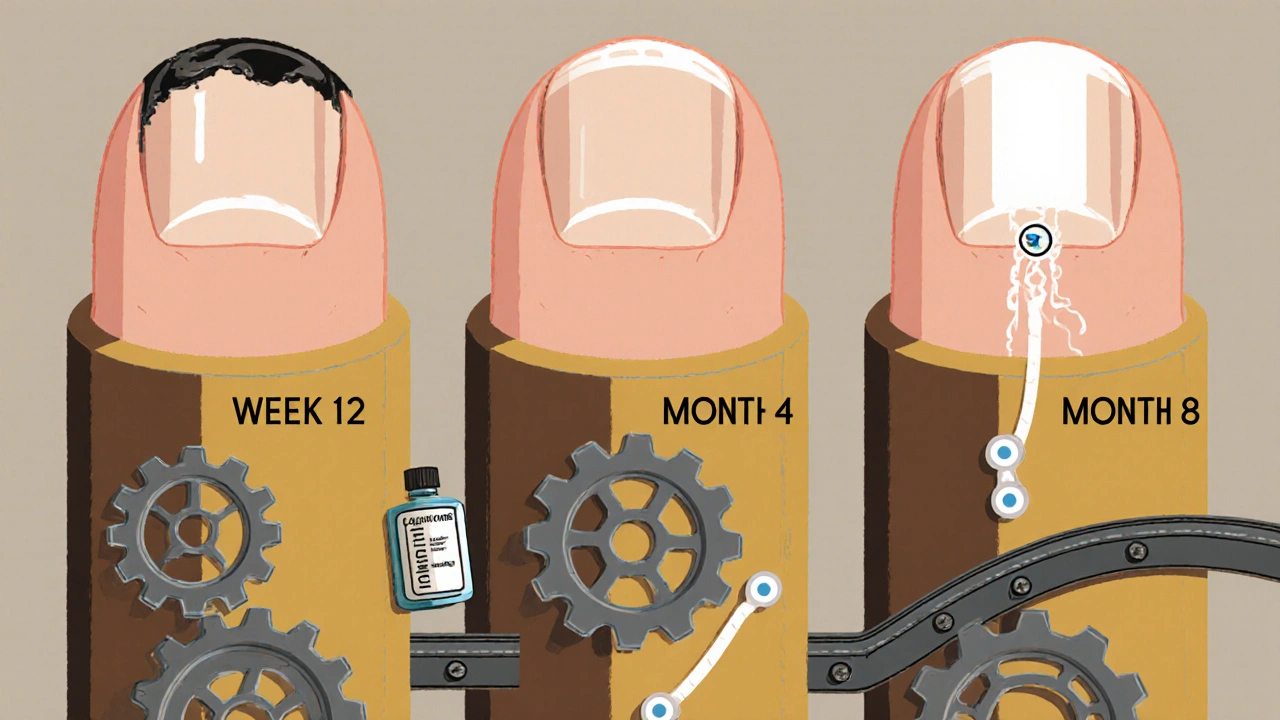When psoriasis affects your nails, it’s not just a cosmetic issue. Thickened, pitted, or crumbling nails can make everyday tasks painful and frustrating. Unlike skin psoriasis, nail psoriasis doesn’t respond well to creams or light therapy alone. That’s where calcipotriol comes in - a topical treatment that’s quietly become one of the most effective options for people struggling with this stubborn form of the disease.
What Is Calcipotriol?
Calcipotriol is a synthetic form of vitamin D3, specifically designed to slow down the overgrowth of skin cells that causes psoriasis. It’s not a steroid, so it doesn’t carry the same risk of thinning skin with long-term use. Instead, it works by regulating how skin cells mature and shed. This makes it ideal for areas like the nails, where thickened skin and abnormal growth are the main problems.
It’s available as a cream, ointment, or solution - and for nail psoriasis, the solution form is most commonly used. The solution is applied directly to the affected nail and surrounding skin, allowing it to penetrate deeper than creams or ointments can.
Why Nail Psoriasis Is So Hard to Treat
Nail psoriasis affects up to 50% of people with plaque psoriasis. The nail unit is a complex structure - the nail plate, nail bed, and matrix are all protected by layers of hard keratin. Most topical treatments can’t reach deep enough to make a difference. Even when they do, the slow growth rate of nails (about 1.5 mm per month) means results take months to show.
Traditional treatments like corticosteroid injections or oral medications carry risks: steroid injections are painful and not always effective; systemic drugs like methotrexate or biologics can have serious side effects. That’s why many dermatologists now recommend starting with calcipotriol - especially when the condition is mild to moderate.
How Calcipotriol Works on Nails
Calcipotriol targets the nail matrix, the area under the cuticle where new nail cells are made. In psoriasis, this area becomes inflamed and produces abnormal, brittle nail cells. Calcipotriol reduces inflammation and helps restore normal cell turnover.
Studies show that when applied daily for 12 to 24 weeks, calcipotriol improves nail appearance in 60-70% of patients. Improvements include reduced pitting, less thickening, and clearer nail plates. One 2023 clinical trial published in the Journal of the American Academy of Dermatology found that 68% of participants saw at least a 50% improvement in their Nail Psoriasis Severity Index (NAPSI) score after 20 weeks of treatment.
It doesn’t cure nail psoriasis - no treatment does - but it significantly slows progression and can even reverse damage over time.
How to Use Calcipotriol for Nail Psoriasis
Using calcipotriol correctly matters more than with skin psoriasis. Here’s how to get the most out of it:
- Trim your nails as short as possible. This lets the solution reach the nail bed more easily.
- Clean the nail surface with alcohol or soap and water. Remove any polish or debris.
- Apply one drop of calcipotriol solution directly onto the affected nail and the surrounding skin (cuticle area).
- Gently massage it in with your fingertip - don’t rinse it off.
- Apply once daily, preferably at night before bed.
- Be patient. It takes at least 12 weeks to see changes. Full results may take 6 months.
Some people use a small brush or cotton swab to apply the solution precisely. Avoid getting it on healthy skin around the nail - it can cause mild irritation.

Side Effects and Safety
Calcipotriol is generally well-tolerated. The most common side effects are mild: redness, itching, or peeling around the nail. These usually fade after a few weeks as your skin adjusts.
Unlike oral treatments, calcipotriol doesn’t affect your liver or kidneys. But because it’s a vitamin D analog, you should avoid using it with other vitamin D supplements unless your doctor approves. Too much vitamin D can raise calcium levels in your blood - rare with topical use, but possible if you apply it over large areas daily.
It’s safe for long-term use. Many patients use it for 6 months to a year with no issues. If irritation becomes severe, stop use and talk to your dermatologist.
Combining Calciptriol With Other Treatments
For better results, calcipotriol is often paired with other therapies:
- Topical corticosteroids - applied after calcipotriol to reduce inflammation. Some formulations combine both in one product.
- Urea-based creams - help soften thick nails so calcipotriol penetrates deeper.
- Phototherapy - narrowband UVB light applied to the fingers can enhance calcipotriol’s effect.
- Biologics - if nail psoriasis is severe and widespread, doctors may recommend injectable biologics like secukinumab or ixekizumab alongside topical treatment.
One study found that patients using calcipotriol with a 10% urea cream saw 30% faster improvement than those using calcipotriol alone. The urea helped break down the hardened nail, letting the medication reach the root of the problem.
Who Should Avoid Calcipotriol?
Calcipotriol isn’t for everyone. Avoid it if you:
- Have a known allergy to vitamin D or its derivatives
- Have high calcium levels in your blood (hypercalcemia)
- Are pregnant or breastfeeding - while topical use is low risk, safety data is limited
- Have open wounds or infections around the nail - treat those first
If you’re unsure, talk to your dermatologist. They can test your calcium levels and check for other conditions that might affect treatment.

What to Expect Over Time
Improvement with calcipotriol is gradual. Here’s a realistic timeline:
- Weeks 1-4: No visible change. Nail growth is slow. Stick with it.
- Weeks 6-12: Pitting may start to fill in. Nail color may lighten slightly.
- Month 4-6: Noticeable thinning of thickened nails. Less crumbling.
- Month 8-12: New, healthy nail growth appears from the base. Old damaged nail grows out and is replaced.
Don’t get discouraged if you don’t see results right away. Nail psoriasis takes patience. Many patients stop too soon - and then wonder why it didn’t work.
When to See a Dermatologist
You don’t need to wait until your nails are completely ruined to get help. See a dermatologist if:
- Your nails are painful or interfere with daily tasks
- You notice signs of infection - pus, swelling, red streaks
- More than three nails are affected
- Skin psoriasis is spreading or worsening
Early treatment prevents permanent damage. Once the nail matrix is scarred, even the best treatments can’t fully restore the nail.
Real Results: What Patients Say
One patient, Maria, 47, from Portland, started using calcipotriol after years of failed treatments. Her thumbnails were completely thickened and yellowed. After six months of daily use, her nails looked almost normal. "I could finally wear sandals again," she said. "It wasn’t magic - but it was the first thing that actually worked."
Another, James, 59, from Chicago, used calcipotriol with a urea cream. He saw improvement in three nails, but not the fourth - the one with the most damage. "It didn’t fix everything," he said, "but it saved three of them. That’s better than I expected."
These stories aren’t rare. They’re the norm for people who stick with the treatment.
Can calcipotriol cure nail psoriasis completely?
No, calcipotriol cannot cure nail psoriasis. Psoriasis is a chronic autoimmune condition, and no current treatment eliminates it permanently. But calcipotriol can significantly improve nail appearance, reduce symptoms, and prevent further damage. Many patients achieve near-normal nail growth with consistent use.
How long does it take for calcipotriol to work on nails?
It takes at least 12 weeks to see any change, and full results can take 6 to 12 months. Nails grow slowly - about 1.5 mm per month - so new, healthy nail tissue replaces the damaged part over time. Patience and consistency are key.
Is calcipotriol better than steroid creams for nail psoriasis?
Calcipotriol is often preferred over steroid creams for nails because it doesn’t thin the skin or cause long-term damage. Steroid creams can help reduce inflammation quickly, but they’re less effective at reversing nail thickening and pitting. Calcipotriol targets the root cause - abnormal cell growth - making it more effective for long-term improvement.
Can I use calcipotriol with nail polish?
Avoid nail polish while using calcipotriol. Polish creates a barrier that blocks the medication from reaching the nail bed. If you must wear polish, apply calcipotriol at night and remove polish daily before application. Let the treatment absorb fully before reapplying polish.
What if calcipotriol doesn’t work for me?
If you’ve used calcipotriol daily for 6 months with no improvement, talk to your dermatologist. You may need a stronger treatment, such as a biologic medication or a combination of therapies. Sometimes, adding urea cream or phototherapy helps. Never stop treatment without medical advice - stopping too early can make results worse.
If you’re dealing with nail psoriasis, calcipotriol is one of the most practical, safe, and effective options available. It’s not flashy, and it doesn’t work overnight - but for many, it’s the difference between living with damaged nails and regaining normal function and confidence.






calcipotriol sounds like a fancy word for "try not to scratch your nails till they bleed" but honestly i tried it for 3 months and my nails still look like they survived a war
October 30Mamadou Seck